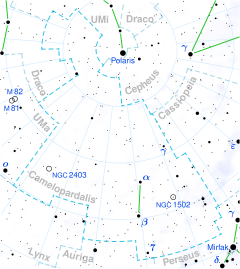Beta Camelopardalis
| Observation data Epoch J2000 Equinox J2000 | |
|---|---|
| Constellation | Camelopardalis |
| Right ascension | 05h 03m 25.08963s[1] |
| Declination | +60° 26′ 32.0895″[1] |
| Apparent magnitude (V) | 4.02[2] |
| Characteristics | |
| Spectral type | G1Ib–IIa[3] |
| U−B color index | +0.62[2] |
| B−V color index | +0.93[2] |
| R−I color index | +0.49[2] |
| Astrometry | |
| Radial velocity (Rv) | −1.90[4] km/s |
| Proper motion (μ) | RA: −6.50[1] mas/yr Dec.: −14.15[1] mas/yr |
| Parallax (π) | 3.74 ± 0.21 mas[1] |
| Distance | 870 ± 50 ly (270 ± 20 pc) |
| Absolute magnitude (MV) | −3.1[5] |
| Details | |
| Mass | 6.5[3] M☉ |
| Radius | 58±13[6] R☉ |
| Luminosity | 1,592[7] L☉ |
| Surface gravity (log g) | 1.79[3] cgs |
| Temperature | 5,300[3] K |
| Metallicity [Fe/H] | −0.06[8] dex |
| Rotational velocity (v sin i) | 11.7[9] km/s |
| Age | 53[3] Myr |
| Other designations | |
| Database references | |
| SIMBAD | data |
| Data sources: | |
| Hipparcos Catalogue, CCDM (2002), Bright Star Catalogue (5th rev. ed.) | |
Beta Camelopardalis, Latinised from β Camelopardalis, is the brightest star in the northern constellation of Camelopardalis. It is bright enough to be faintly visible to the naked eye, having an apparent visual magnitude of 4.02.[2] Based upon an annual parallax shift of 3.74 mas as seen from Earth, it is located roughly 870 light-years from the Sun. It is moving closer with a radial velocity of −1.90 km/s[4] and is most likely a single[10] star.
This is a yellow-hued G-type supergiant/bright giant with a stellar classification of G1 Ib–IIa.[3] It is an estimated 60 million years old and is spinning with a projected rotational velocity of 11.7 km/s.[9] This is an unusually high rate of rotation for an evolved star of this type. One possible explanation is that it may have engulfed a nearby giant planet, such as a hot Jupiter.[11]
Beta Camelopardalis has 6.5[3] times the mass of the Sun and has expanded to around 58[6] the Sun's radius. The star is radiating 1,592[7] times the Sun's luminosity from its enlarged photosphere at an effective temperature of 5,300 K.[3] It is a source of X-ray emission.[12]
β Cam has two visual[10] companions: a 7th-magnitude A5-class star at an angular separation of 84 arcseconds; and a 12th-magnitude star at 15 arcseconds.[13]
References
[edit]- ^ a b c d e Van Leeuwen, F. (2007). "Validation of the new Hipparcos reduction". Astronomy and Astrophysics. 474 (2): 653–664. arXiv:0708.1752. Bibcode:2007A&A...474..653V. doi:10.1051/0004-6361:20078357. S2CID 18759600.
- ^ a b c d e Ducati, J. R. (2002). "VizieR Online Data Catalog: Catalogue of Stellar Photometry in Johnson's 11-color system". CDS/ADC Collection of Electronic Catalogues. 2237. Bibcode:2002yCat.2237....0D.
- ^ a b c d e f g h Lyubimkov, Leonid S.; Lambert, David L.; Korotin, Sergey A.; Rachkovskaya, Tamara M.; Poklad, Dmitry B. (2015). "Carbon abundance and the N/C ratio in atmospheres of A-, F- and G-type supergiants and bright giants". Monthly Notices of the Royal Astronomical Society. 446 (4): 3447. arXiv:1411.2722. Bibcode:2015MNRAS.446.3447L. doi:10.1093/mnras/stu2299.
- ^ a b Gontcharov, G. A. (2006). "Pulkovo Compilation of Radial Velocities for 35 495 Hipparcos stars in a common system". Astronomy Letters. 32 (11): 759–771. arXiv:1606.08053. Bibcode:2006AstL...32..759G. doi:10.1134/S1063773706110065. S2CID 119231169.
- ^ Gray, David F.; Pugh, Teznie (2012). "The Third Signature of Granulation in Bright-giant and Supergiant Stars". The Astronomical Journal. 143 (4): 92. Bibcode:2012AJ....143...92G. doi:10.1088/0004-6256/143/4/92.
- ^ a b Van Belle, G. T.; et al. (2009). "Supergiant temperatures and linear radii from near-infrared interferometry". Monthly Notices of the Royal Astronomical Society. 394 (4): 1925. arXiv:0811.4239. Bibcode:2009MNRAS.394.1925V. doi:10.1111/j.1365-2966.2008.14146.x. S2CID 118372600.
- ^ a b McDonald, I.; Zijlstra, A. A.; Boyer, M. L. (2012). "Fundamental parameters and infrared excesses of Hipparcos stars". Monthly Notices of the Royal Astronomical Society. 427 (1): 343–357. arXiv:1208.2037. Bibcode:2012MNRAS.427..343M. doi:10.1111/j.1365-2966.2012.21873.x. S2CID 118665352.
- ^ Kovtyukh, V. V.; Gorlova, N. I.; Belik, S. I. (2012). "Accurate luminosities from the oxygen λ7771-4 Å triplet and the fundamental parameters of F-G supergiants". Monthly Notices of the Royal Astronomical Society. 423 (4): 3268. arXiv:1204.4115. Bibcode:2012MNRAS.423.3268K. doi:10.1111/j.1365-2966.2012.21117.x. S2CID 118683158.
- ^ a b Rodrigues Da Silva, R.; Canto Martins, B. L.; De Medeiros, J. R. (2015). "On the Nature of Rapidly Rotating Single Evolved Stars". The Astrophysical Journal. 801 (1): 54. arXiv:1503.03447. Bibcode:2015ApJ...801...54R. doi:10.1088/0004-637X/801/1/54. S2CID 119271718.
- ^ a b Eggleton, P. P.; Tokovinin, A. A. (September 2008). "A catalogue of multiplicity among bright stellar systems". Monthly Notices of the Royal Astronomical Society. 389 (2): 869–879. arXiv:0806.2878. Bibcode:2008MNRAS.389..869E. doi:10.1111/j.1365-2966.2008.13596.x. S2CID 14878976.
- ^ Rodrigues da Silva, R.; Canto Martins, B. L.; De Medeiros, J. R. (March 2015). "On the Nature of Rapidly Rotating Single Evolved Stars". The Astrophysical Journal. 801 (1): 6. arXiv:1503.03447. Bibcode:2015ApJ...801...54R. doi:10.1088/0004-637X/801/1/54. S2CID 119271718. 54.
- ^ Haakonsen, Christian Bernt; Rutledge, Robert E. (September 2009), "XID II: Statistical Cross-Association of ROSAT Bright Source Catalog X-ray Sources with 2MASS Point Source Catalog Near-Infrared Sources", The Astrophysical Journal Supplement, 184 (1): 138–151, arXiv:0910.3229, Bibcode:2009ApJS..184..138H, doi:10.1088/0067-0049/184/1/138, S2CID 119267456
- ^ Mason, Brian D.; Wycoff, Gary L.; Hartkopf, William I.; Douglass, Geoffrey G.; Worley, Charles E. (2001). "The 2001 US Naval Observatory Double Star CD-ROM. I. The Washington Double Star Catalog". The Astronomical Journal. 122 (6): 3466. Bibcode:2001AJ....122.3466M. doi:10.1086/323920.

